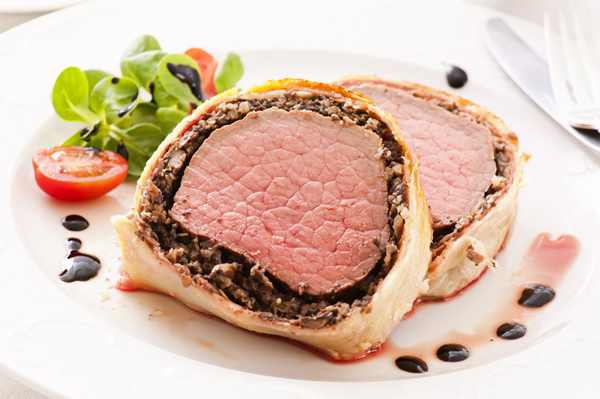If homemade soup is comfort in a cup, Beef Wellington is indulgence on a platter.
It starts with luxurious ingredients and comes to table in elegant golden glory.
A beautifully medium-rare beef fillet, pâté, and duxelles wrapped in puff pastry and baked to flaky, crusty perfection is a dish that hails “celebration.”
Serve Beef Wellington as you would dress to impress. It’s not your any-night-of-the-week meal thrown together after a long, hard day of work. Rather, it is a dish that demands attention in its preparation—and commands attention when presented to your dining companions.

Origins of the Dish
Various claims exist for the origins of Beef Wellington, starting with Arthur Wellesley, the first Duke of Wellington and the Anglo-Irish general who brought down Napoleon at Waterloo. Wellington is said to have had a fondness for a dish of fillet, truffles, and Madeira, cooked in pastry. Documentation, however, doesn’t support this.
One other theory that connects the dish to the duke is that a well-browned Beef Wellington resembled the brown, shiny military boots that were named after the duke—Wellingtons, or Wellies in common use.
Another claim suggests that, during the Napoleonic Wars, an unnamed British chef created the dish as an Anglicized version of the French dish, filet de boeuf en croûte.
And yet another theory holds that the dish originated in Wellington, New Zealand, where it was created for a civic gala.
The Ingredients
The ne plus ultra Beef Wellington could very well be the Lobels’ recipe for a glamorous preparation that calls for pâté de foie gras and truffles to accompany a whole USDA Prime or Wagyu tenderloin.
And while serving an entire tenderloin is truly impressive, Wellington can also be made in single portions by slicing the tenderloin into individual filets mignon before building and baking deliriously rich pastry packets.
Duxelles are an integral component and common to most recipes, whereas the inclusion of pâté varies from version to version.
Duxelles are minced mushrooms of just about any variety that can be uncooked, sautéed alone, or sautéed with other such ingredients like shallots, garlic, sherry, or port wine. Sauteeing helps to remove the water from the mushrooms, thus concentrating their flavor.
Pâté of any sort will work. Although some variations of the recipe substitute for the pâté a layer of dry-cured ham—such as prosciutto or Serrano—and then spreading it with the duxelles before centering the fillet and rolling it into the pastry.
Whether you choose to use ham, pâté, or something entirely different, the point is to add some fat and a whole lot of flavor to the tenderloin, which is a comparatively lean cut on its own.
Do you adore Beef Wellington? What is your favorite variation? Have you ever tried making this Culinary Classic at home? Any tips or tricks?



Leave Your Response